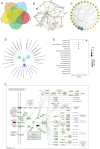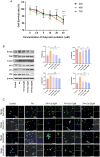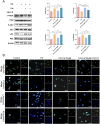Regulation of autophagy by the PI3K-AKT pathway in Astragalus membranaceus - Cornus officinalis to ameliorate diabetic nephropathy
- PMID: 40432887
- PMCID: PMC12106390
- DOI: 10.3389/fphar.2025.1505637
Regulation of autophagy by the PI3K-AKT pathway in Astragalus membranaceus - Cornus officinalis to ameliorate diabetic nephropathy
Abstract
Aims and background: Autophagy plays an increasingly significant role in diabetic nephropathy (DN), but the mechanism by which autophagy participates in DN injury is not well understood. Our previous studies have shown that Astragalus membranaceus - Cornus officinalis (AM-CO) improves DN lipid metabolism disorders, however, the exact mechanism of which is also not well defined. The aim of this study was to investigate the therapeutic effects of AM-CO officinalis on DN and the mechanism of action on DN using lipidomic techniques and network pharmacological approaches.
Experimental methods: The in vivo experiments were carried out using the KKAy mice model with the intervention of AM-CO. Analysis of kidney and serum samples from KKAy mice treated with AM-CO using lipidomic technology to obtain biomarkers for the treatment of DN and to identify the main targets associated with DN; Analyse potential signalling pathways for the treatment of DN using network pharmacology methods. In vitro experiments were performed with PA-induced HK-2 cells and results verified by protein blotting and immunofluorescence.
Results: Lipidomic analysis revealed 363 differential metabolites in serum and 195 differential metabolites in kidney tissue, which were compared and analysed to find their common differential metabolites belonging to the phosphatidylethanolamine (PE) classes, respectively. In addition, PE plays a vital functiona in the process of autophagy. And the network analysis results speculated that Calycosin (Cal), a major component of AM-CO, could ameliorate DN injury by regulating autophagy through modulating the PI3K-AKT signaling pathway. In vivo experiments showed that AM-CO could induce autophagy, an increase in LC3II expression and a decrease in P62 expression. Meanwhile, in vitro experiments showed that Cal could also increase the expression of LC3II and inhibit the protein expression levels of p62, PI3K, P-AKT and AKT. The addition of a PI3K activator resulted in a reversal of protein expression.
Conclusion: In conclusion, Cal can ameliorate the injury in DN by regulating autophagy, and PI3K-AKT is the main pathway for its regulation of autophagy and a key pathway for the action of AM-CO.
Keywords: Astragalus membranaceus -Cornus officinalis; calycosin; diabetic nephropathy; lipidomic technology; network analysis.
Copyright © 2025 Zhang, Lan, Zhu, Wang, Liu and Li.
Conflict of interest statement
The authors declare that the research was conducted in the absence of any commercial or financial relationships that could be construed as a potential conflict of interest.
Figures







Similar articles
-
Network pharmacology-based identification of miRNA expression of Astragalus membranaceus in the treatment of diabetic nephropathy.Medicine (Baltimore). 2022 Feb 4;101(5):e28747. doi: 10.1097/MD.0000000000028747. Medicine (Baltimore). 2022. PMID: 35119030 Free PMC article.
-
Uncovering the Mechanism of Astragalus membranaceus in the Treatment of Diabetic Nephropathy Based on Network Pharmacology.J Diabetes Res. 2020 Mar 2;2020:5947304. doi: 10.1155/2020/5947304. eCollection 2020. J Diabetes Res. 2020. PMID: 32215271 Free PMC article.
-
Tanshinone IIA Promoted Autophagy and Inhibited Inflammation to Alleviate Podocyte Injury in Diabetic Nephropathy.Diabetes Metab Syndr Obes. 2024 Jul 22;17:2709-2724. doi: 10.2147/DMSO.S464015. eCollection 2024. Diabetes Metab Syndr Obes. 2024. PMID: 39072344 Free PMC article.
-
Cornus officinalis prior and post-processing: Regulatory effects on intestinal flora of diabetic nephropathy rats.Front Pharmacol. 2022 Oct 7;13:1039711. doi: 10.3389/fphar.2022.1039711. eCollection 2022. Front Pharmacol. 2022. PMID: 36278215 Free PMC article.
-
Research progress on Cornus officinalis and its active compounds in the treatment of diabetic nephropathy.Front Pharmacol. 2023 Jul 5;14:1207777. doi: 10.3389/fphar.2023.1207777. eCollection 2023. Front Pharmacol. 2023. PMID: 37475719 Free PMC article. Review.
References
-
- Danfeng L., Xiaojie C, Weiting H., Min L., Qiuling L., Shaogui Z., et al. (2024). Update on the pathogenesis, diagnosis, and treatment of diabetic tubulopathy. Integra. Medi. Nephro. Andro. 11 (4), e23–00029. 10.1097/IMNA-D-23-00029 - DOI
LinkOut - more resources
Full Text Sources

